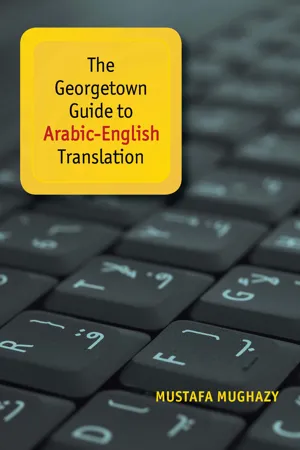
- 312 pages
- English
- PDF
- Available on iOS & Android
The Georgetown Guide to Arabic-English Translation
About This Book
"Translation is like a reverse-engineering process—whereby, say, we might take apart a clock made of metal parts in order to build a functioning replica made entirely of plastic. Our final product will not look the same as the original clock, and it would be impossible to simply copy the designs of its inner workings, because plastic and metals have very different properties. For example, we cannot make small plastic springs or very thin gears of plastic. But these changes do not matter; the only thing that matters is that our replica will tell the time correctly."—From the Introduction
The Georgetown Guide to Arabic-English Translation is an essential step-by-step, practical manual for advanced learners of Arabic interested in how to analyze and accurately translate nonfiction Arabic texts ranging from business correspondence to textbooks.
Mustafa Mughazy, a respected Arabic linguist, presents an innovative, functional approach that de-emphasizes word-for-word translation. Based on the Optimality Theory, it favors remaining faithful to the communicative function of the source material, even if this means adding explanatory text, reconfiguring sentences, paraphrasing expressions, or omitting words.
From how to select a text for translation or maintain tense or idiom, to how to establish translation patterns, The Georgetown Guide to Arabic-English Translation is useful both as a textbook and a reference. An invaluable set of appendices offers shortcuts to translate particularly difficult language like abbreviations, collocations, and common expressions in business correspondence, while authentic annotated texts provide the reader opportunities to practice the strategies presented in the book. A must-read for advanced learners of Arabic, this is a book every scholar and graduate-level student will wish to own.
Frequently asked questions
Information
Table of contents
- Cover
- Contents
- Acknowledgments
- Introduction: Who Needs a Manual for Arabic–English Translation Anyway?
- 1 Getting Words Across: Word-Level Translation Problems and Strategies
- 2 Putting Words Together: Phrase-Level Translation Problems and Strategies
- 3 Inside the Sentence: Functional Categories
- 4 The Sentence and Beyond: Discourse and Genre Features
- Annotated Texts for Translation
- Answer Key
- Appendixes
- Bibliography
- Index